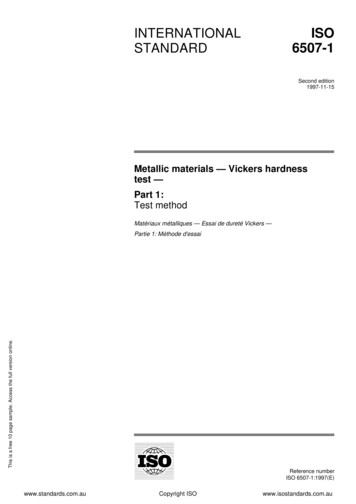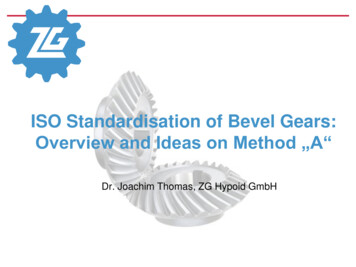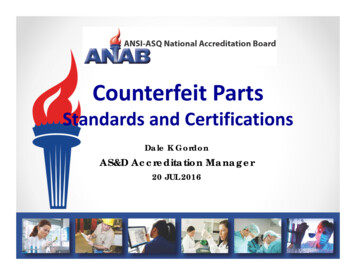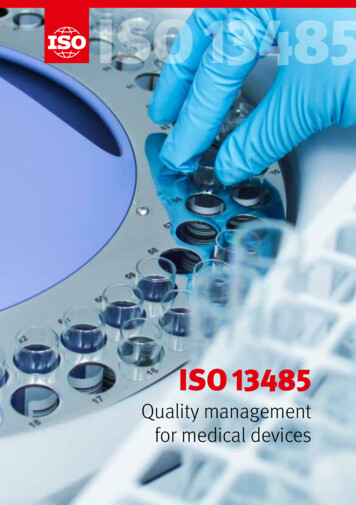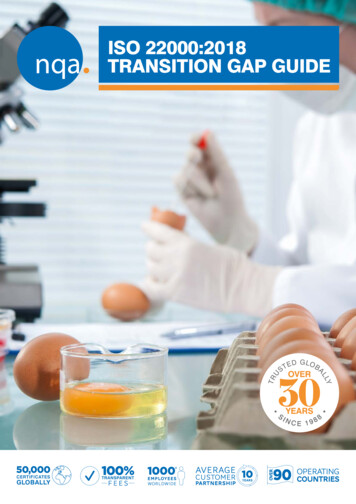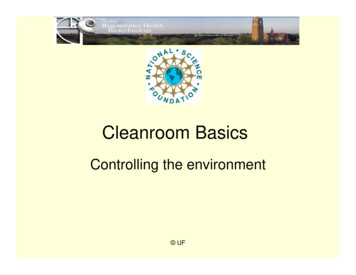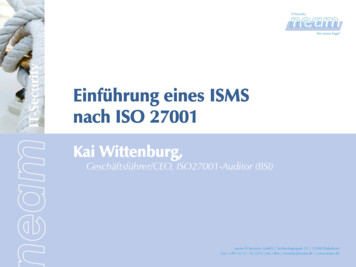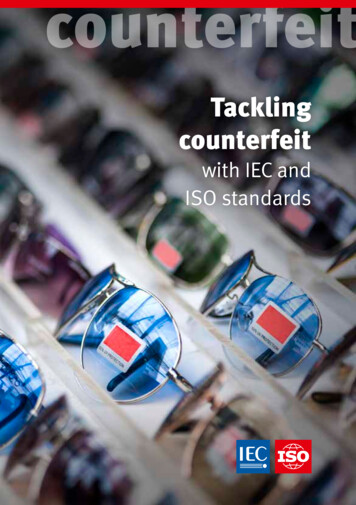
Transcription
counterfeitTacklingcounterfeitwith IEC andISO standards
Tackling counterfeitwith IEC andISO standardsIn Roman times it was wine,in mediaeval times it was textilesand weapons, today it is everythingfrom personal computers to potencypills. Counterfeit goods are nothingnew, but with globalization, the Internetand increased movement of goods,the fakes business is booming.
The global value of counterfeit goods was estimated as being worth betweenUSD 923 billion and USD 1.13 trillion in 2016 alone 1), costing millions of jobsand funding further abuses such as corruption and violence.Counterfeit affects virtually every country in the world, fuels illegal activitiesand harms you and your family. Aircraft, automotive parts, medicines, toys,electronic equipment, clothing and foodstuffs are just some of the productstarnished by the counterfeit industry.IEC and ISO have dedicated committees working on standards and solutions tohelp combat counterfeit and provide increased confidence to consumers. Theseinclude standards that test for authenticity, provide guidelines to measure thecompetency of testing laboratories and provide quality and minimum safetyguidelines. For electric and electronic goods, the IEC offers testing and certification services that assist in quality and supply chain management, ensuringthat suppliers deliver authentic parts and end products are safe to use.1) Global Financial IntegrityTackling counterfeit with IEC and ISO standards–1
What exactly are counterfeit goods ?The World Trade Organization (WTO) defines product counterfeiting as the“ unauthorized representation of a registered trademark carried on goodsidentical or similar to goods for which the trademark is registered, with aview to deceiving the purchaser into believing that he/she is buying the original goods ”. 2)IEC defines counterfeit as “ goods made to imitate something of value, whichmay not be made with the same level of safety, quality or reliability ”.ISO defines a counterfeit as a “ material good imitating or copying an authenticmaterial good ”. 3)Definitions vary, but there is a distinction between trademark misuse and pureproduct fraud, even if counterfeiting is often understood to cover both cases.How does counterfeit affect you ?At best, buying counterfeit goods is a waste of money. At worst, they can posea significant risk to health and safety.In addition, measures to prevent or combat counterfeit cost regulators andindustry time and money, which consumers ultimately pay for.2) WTO Glossary3) ISO 12931:2012, def. 2.62 – Tackling counterfeit with IEC and ISO standards
Tackling counterfeit with IEC and ISO standards–3
IEC standardsToday, electrical and electronicproducts and their components maybe manufactured and assembled in,and transit through, any number ofcountries. Along the way, they maybe handled by different manufacturers and distributers before reachingThe Systems are :IECEE : electrical and electronicequipment (e.g. electric vehicles,garden and household appliances,medical devices, office equipment,toys, batteries, cables, capacitators)the final users. To ensure the safeIECEx : equipment used in explosiveuse of these products and systems,atmospheres (e.g. gas and oil refiner-it is essential to be able to guaranteeies, farm grain storage and personneltheir safety, quality, reliability andoperating equipment in such areas)interoperability. IEC helps achievethis by developing consensus-basedInternational Standards, againstwhich these products are tested in thefour global Conformity AssessmentSystems it operates.IECQ : quality of electronic compo-nents, associated materials, assemblies and processes (e.g. automotivecomponents, avionics parts andassembly management, LED lightingand more)IECRE : equipment for use in renew-able energies, including solar, marineand wind4 – Tackling counterfeit with IEC and ISO standards
ISO standardsBy defining internationally agreedrequirements related to products, services and systems, ISO InternationalStandards can help to make supplychains more transparent and secure,These include :ISO 12931, Performance criteria forauthentication solutions used to combat counterfeiting of material goodsinstilling confidence in consumersISO 16678, Guidelines for interoper-that what they are buying is legiti-able object identification and relatedmate, as well as assisting regulatorsauthentication systems to deter coun-in implementing preventive policies.terfeiting and illicit tradeISO also has a number of standardsthat can be used specifically forauthenticating products, to demonstrate that they are what they claimto be.ISO 28000, Specification for securitymanagement systems for the supply chainISO 22000, Food safety managementsystems – Requirements for any organization in the food chainTackling counterfeit with IEC and ISO standards–5
The role of conformity assessmentIEC and ISO work on a number of standards that help with conformity assessment,namely standards that demonstrate that products, services or systems meet therequirements of standards and are thus legitimate. These include a “ toolbox ” ofstandards and guides that assist regulators and market surveillance authorities,under the responsibility of ISO’s committee for conformity assessment, CASCO : ISO/IEC 17000, Conformity assessment –Vocabulary and general principles ISO/IEC 17020, Conformity assessment –Requirements for the operation of varioustypes of bodies performing inspection ISO/IEC 17021-1, Conformity assessment– Requirements for bodies providing auditand certification of management systems– Part 1 : Requirements ISO/IEC 17025, General requirements forthe competence of testing and calibrationlaboratories ISO/IEC 17065, Conformity assessment– Requirements for bodies certifyingproducts, processes and services6 – Tackling counterfeit with IEC and ISO standards ISO/TS 22003, Food safety managementsystems – Requirements for bodiesproviding audit and certification of foodsafety management systems ISO/IEC Guide 23, Methods of indicatingconformity with standards for third-partycertification systems ISO Guide 27, Guidelines for correctiveaction to be taken by a certification bodyin the event of misuse of its mark ofconformity
Tackling counterfeit with IEC and ISO standards–7
8 – Tackling counterfeit with IEC and ISO standards
Fake or illegally reproduced goodsare found across almost every industry.Below are some examples of wherethey are most prevalent.PharmaceuticalsInitially the preserve of developingdate. They may cause harm to userscountries, fake drugs are now wide-from incorrect ingredients used orspread virtually everywhere.simply not treat the condition theyA culture of self-prescribing and morewere designed for. Counterfeit drugsinformed consumers, coupled withaffect the entire supply chain, fromthe proliferation of unregulated Web-rogue pharmaceutical companies tosites, has enabled the fake medicinescorrupt local officials, pharmacistsindustry to flourish into a multibillionand physicians.dollar industry, affecting countriesIn 2013, the World Health Organiza-rich and poor.tion (WHO) launched a global sur-Counterfeit medications includeveillance and monitoring system tothose with the right ingredients butencourage countries to report inci-in the wrong amounts, those withdents of counterfeit drugs and, as atharmful or inactive ingredients, andJanuary 2016, more than 920 medi-medication that is expired but rela-cines were reported, representing allbelled with a different expirationthe main therapeutic areas.Tackling counterfeit with IEC and ISO standards–9
What are the risks of fake drugs ?Antibiotic resistance : Fake antibiot-Death and illness : When a medica-ics with a low concentration of activetion contains toxic or harmful sub-ingredients do damage worldwidestances or, on the contrary, no activeby stimulating the development ofingredients, patients may, at best,drug resistance in surviving bacteria.miss out on potentially life-savingIneffective or incomplete courses oftreatment ; at worst, they could sufferantibiotic treatment are dangerous,from the effects of a toxic, untested oreven life-threatening.non-approved product.How can I spot a fake ?There are a number of things you can look out for when purchasing medicines :Buying onlineThe medication itself Does the Website look reputable ? Is it the correct dosage ? Is it free from spelling mistakes ? Does the product look right in Does it display a physical addressor contact details ? terms of colour and texture ? Is it offering prescriptiononly drugs without requiringAre the security seals intact withno signs of tampering ? a prescription ?Is the packaging in good condition, with no spelling mistakesand with a patient information leaflet ? Does the customs declarationdeclare the contents as medicine ? 10 – Tackling counterfeit with IEC and ISO standardsIs the price too good to be true ?
Standards that can helpHealthcare regulators, medicine suppliers and other providers in the healthcare industry face increasing pressure to ensure their supply chains are safeand secure and prevent falsification of medicinal products. Machine-readablecoding is a reliable way of achieving that.ISO / TS 16791, Health informaticsISO 28000, Specification for security– Requirements for internationalmanagement systems for the supplymachine-readable coding of medicinalchain, specifies the requirements for aproduct package identifiers, providessecurity management system, includ-guidance for machine-readable cod-ing those aspects critical to securitying based on globally harmonizedassurance of the supply chain and alland interoperable standards, whichactivities controlled or influenced bycan be used internationally on aorganizations that impact on supplywide scale, thus providing essentialchain security.support to the industry in preventingcounterfeit products.Tackling counterfeit with IEC and ISO standards– 11
ElectronicsOf the many types of counterfeitAcross the board, in order for manu-goods, electrical and electronic prod-facturers and consumers to haveucts now occupy second place in vol-confidence in the components andume after pharmaceuticals. Today, wedevices they make and use, theseuse and come into contact with count-products must fulfil all safety, qual-less such devices and appliances,ity, reliability and interoperabilityincluding household goods, officecriteria as they move through globalequipment and toys, which may con-supply chains.tain numerous components that canMoreover, inspection and third-partybecome the target of counterfeiters.testing can be especially effective,Additionally, the advent of theenabling such products to be discov-Internet of Things has increased theered before they enter a manufac-number of connected devices, suchturer’s supply chain or a country’sas smartphones, tablets, home appli-distribution system.ances or receivers, which we use forcommunicating, making purchases,online banking and more. Smartmedical (wearable) devices monitor,regulate and can share informationpertaining to different health conditions of the user directly with healthcare professionals. In the transportindustry, electronics and their systems form key parts of aeroplanes andare transforming the automobile aswe head towards driverless vehicles.12 – Tackling counterfeit with IEC and ISO standards
Tackling counterfeit with IEC and ISO standards– 13
What are the risks of counterfeitelectrical or electronic devices ?How to spot a fakeIf counterfeit components or prod-inspection, you can discover fakes byucts enter the manufacturing supplychecking packaging and labelling forchain, they may represent severestrange use of language, grammati-safety hazards, which could result incal errors, odd layout, unusual printfires, shocks and explosions. Faultyfonts, lack of a certification stampcounterfeit products can causeor label, or the legibility and sharp-accidents, cost lives and/or dam-ness of markings and logos. Finally,age property.touch the product to see if it seemsAdditionally, a fake component canheavier than usual, or if a cord is thecompromise entire systems andcorrect thickness.installations, which may result inBuyers may want to verify test cer-serious financial losses and liabilities.tificates and documentation shippedIn addition to third-party testing andwith goods. Check for potential discrepancies between shipping documents and part numbers. Take activemeasures to identify and reportfake products.14 – Tackling counterfeit with IEC and ISO standards
Standards that can helpAnother way to help spot fake merchandise is to address the important issue of counterfeit certificates.IEC Conformity Assessment Systemsare unique in that they contain onlinedatabases, which allow immediateverification of the originally issued“ Certificates of Conformity ” and/or“ Testing Certificates ”. This meansthat if the certificates cannot befound on these databases, they arenot authentic.Tackling counterfeit with IEC and ISO standards– 15
16 – Tackling counterfeit with IEC and ISO standards
FoodSometimes what you put in yourIn 2013, Europeans were outraged tomouth isn’t what you think it is. Thediscover that horsemeat was a keyextent of food fraud can make youingredient in burgers and ready meals(literally) sick. Not to mention thesold in supermarkets under the guisedrain on resources of legitimate foodof other more expensive meats suchretailers, who are estimated to lose upas beef. A major British supermarketto USD 15 billion per year .chain selling the offending items suf-Food fraud is when food is put intofered a EUR 300 million drop in mar-the marketplace with the deliberateket value as a result 5).intention of misleading the consumer,More harmful examples include thegenerally to save money. There aremelamine scandal 6) in 2008 where4)many types, including recycling ani-melamine was added to milk andmal by-products back into the foodinfant formula to increase its proteinchain, selling foods that are past theircontent. This led to the hospitaliza-“ use by ” date, deliberate mislabel-tion of around 54 000 infants, sixling, substituting ingredients withdeaths from kidney stones and, ulti-cheaper alternatives and making falsemately, a number of criminal prosecu-claims about their origin.tions, including two executions.An example is manuka honey, anGovernments everywhere haveexpensive variety of honey producedattempted to crack down on foodonly in New Zealand. Manuka honeyfraud. In an operation 7) conductedmanufacturers in New Zealand esti-in December 2014 and January 2015,mate that 1 700 tonnes are producedInterpol and Europol collected moreeach year, yet up to 10 000 tonnes arethan 2 500 tonnes of counterfeit foods,sold around the world, meaning theincluding items such as eggs andcheaper kinds are falsely labelled.cooking oil, from 47 countries.4)5)6)7)PwCBBC newsForbes magazineEuropolTackling counterfeit with IEC and ISO standards– 17
What are the risks of fake food ?How can I spot a fake ?Risks to health : Consumers riskCheck the price : If it’s too cheap toallergic or toxic reactions whenbe true, it probably is.ingredients are replaced by cheaperalternatives that they are not aware of.Consumer deception : Even if theingredients don’t pose a risk to consumer health, false labelling canresult in people consuming foods thatare against their religious or moralbeliefs, or undermining the trust thatconsumers have in all food manufacturers, even those that are honest.18 – Tackling counterfeit with IEC and ISO standardsCheck the labelling : Are there spelling mistakes ? Does it look how youwould expect ?Check the food : If you suspect it isnot how it should be, contact yourlocal authorities or consumer group.
Standards that can helpISO 22000, Food safety managementOther examples are ISO 17367,systems – Requirements for any organ-Supply chain applications of RFID —ization in the food chain, helps foodProduct tagging, which assists withproducers demonstrate the authen-the traceability of products at eachticity of their products through thestage of the production process,implementation of a food safety man-ISO/IEC 20243 (English only), Infor-agement system. Conformity to themation Technology – Open Trustedstandard requires an organization toTechnology Provider, TM Standarddemonstrate its ability to control food(O-TTPS) – Mitigating maliciouslysafety hazards to ensure that food istainted and counterfeit products,safe at the time of human consump-and ISO/IEC TR 24729-1, Informa-tion as well as demonstrate compli-tion technology – Radio frequencyance with applicable statutory andidentification for item management –regulatory food safety requirements.Implementation guidelines – Part 1 :RFID-enabled labels and packagingsupporting ISO/IEC 18000-6C.Many of IEC and ISO’s conformityassessment standards (see Box,page 6) help to ensure food safetythrough defining requirements forcertification, testing and traceability.Tackling counterfeit with IEC and ISO standards– 19
Consumer productsChildren’s toys, clothing, handbags,DVDs, cigarettes and cosmetics are justsome of the other items that often gethit by counterfeit, costing consumerswasted money and damaging legitimate brands.20 – Tackling counterfeit with IEC and ISO standards
Tackling counterfeit with IEC and ISO standards– 21
What are the risks ?Harmful materials : With no controlsEconomic decline : While it mayin place regarding the manufacture ofbe tempting to buy a fake watch orfake products, the materials used inhandbag at a fraction of the real price,their production can sometimes posesupporting the counterfeit market ata huge risk to consumers’ health. Forthe expense of the legitimate marketexample, fake cigarettes often con-can contribute to unemployment andtain much higher levels of tar andeconomic decline.nicotine, while counterfeit clothingor electronics have been known toinclude higher-than-safe levels ofchemicals such as formaldehyde, leador other harmful substances.Safety : Children’s toys are a key areaof concern for counterfeit products,How can I spot a fake ?Check the price : If it’s too cheap tobe true, it probably isCheck the labelling : For inconsistencies and errors such as spellingas they are less likely to adhere toCheck the product : For inconsistentregulations regarding safety. Somefinishing or details (i.e. paint, metalcounterfeit toys have been knownwork, sizing)to contain harmful levels of phthalates which can increase the risk ofcancer, asthma and infertility laterin life. Many toys contain batteries,electronics or electrical parts, andcounterfeit toys can cause shocks orhave small batteries that are accessible to children, or moving parts thatare not properly protected, causingserious injuries.22 – Tackling counterfeit with IEC and ISO standards
Check with the manufacturerCompanies sometimes make product databasesor directories available to the general public,which allow people to access information themselves on specific products. One such example isthe UL Online Certification Directory. 8)8) Jason Daniels, Senior Investigation Manager,Americas, Global Security & Brand Protection,Underwriters Laboratories, LLCTackling counterfeit with IEC and ISO standards– 23
Standards that can helpISO has many standards for authen-ticating the origins and supply chainof all products as well as productspecific standards that ensure theymeet internationally recognizedsafety requirements.These include the following :ISO 8124 (series), Safety of toys, definesrequirements and test methods for toysintended for use by children under14 years of age, and sets age limits forvarious requirements. It also coversaspects such as flammability, migration of chemical substances, and givesspecific guidance for swings, slides andother activity toys.ISO 12931, Performance criteria forauthentication solutions used to combatcounterfeiting of material goods, specifies performance criteria and evaluation methodology for authenticationsolutions used to establish materialgood authenticity throughout the entirematerial good life cycle.24 – Tackling counterfeit with IEC and ISO standards
ISO 22380 9), Security and resilience– Authenticity, integrity and trust forproducts and documents – Generalprinciples for product fraud risk andcountermeasures, provides generalprinciples for an organization to identify the risks related to various types ofproduct fraud and product fraudsters. Itrecommends that organizations establish strategic business countermeasures in order to prevent or reduce anyharm, tangible or intangible loss andcost from such fraudulent attacks in acost-effective manner.ISO 10377, Consumer product safety– Guidelines for suppliers, assists suppliers of all sizes in assessing and managing the safety of consumer productsfrom design to production, distribution,use and disposal.9) Under developmentTackling counterfeit with IEC and ISO standards– 25
IEC also has many standards thatTesting and certification help verifypromote the safety and reliabilitythat manufacturer promises haveof electronic and electrical devices,been kept and can be trusted. The fourfor example :IEC Conformity Assessment SystemsIEC 62115 for the safety of toys usingdifferent power sources, with at leastone function dependent on electricity,such as a dolls house with a lamp. Itincludes toys which function likeappliances, and some with screensand means of activation, such asa joystick.provide the testing and certificationservices that ensure that electricaland electronic equipment and components are safe to use and workproperly, while ISO standards for conformity assessment help companiesdemonstrate that their products meetthe requirements of a standard andare legitimate. ISO also has standardsIEC 60335 (series) for the safety ofto validate the work of auditors andhousehold and similar electricalthose performing inspection.appliances comprises requirementsIf counterfeit products concern youand test criteria for hazards such asand you wish to report a suspectedelectric shock, fire and toxicity.case, contact a market surveillanceIEC also produces InternationalStandards that deal with the performance, safety and testing of many ofthe product components ; for example, appliance couplers, automaticcontrols for household use, batteries,connecting devices, electric cablesand switches for appliances.26 – Tackling counterfeit with IEC and ISO standardsauthority, fair trading association or a consumer organization inyour country.
Some international enforcement agenciesand bodies performing verification activitiesThe OECD’s publication Trade inInternational Consumer ProtectionCounterfeit and Pirated Goodsand Enforcement Network (ICPEN)– Mapping the Economic Impactwww.icpen.orgwww.oecd.orgInternational AntiCounterfeitingCoalition (IACC)www.iacc.orgInterpolConsumers Internationalwww.consumersinternational.orgFor further information about ISOstandards, contact the ISO memberin your country. www.iso.orgwww.interpol.intInternational Organizationof Legal Metrology (OIML)www.oiml.orgTackling counterfeit with IEC and ISO standards– 27
About IECThe IEC is an independent, not-for-profitorganization that includes 170 countries representing over 99 % of the world population andenergy generation.The IEC worldwide, neutral and independentplatform allows 20 000 experts from the privateand public sectors to cooperate and develop stateof-the-art, globally relevant IEC InternationalStandards that support economic developmentand protect people and the environment. The IECalso administers four Conformity AssessmentSystems whose members verify that devices operate as promised.More informationIEC Website : www.iec.chIEC e-tech : www.iecetech.orgFollow us on :Twitter : www.iec.ch/twitterFacebook : www.iec.ch/facebookGooglePlus : https://plus.google.com/ IECstandards28 – Tackling counterfeit with IEC and ISO standards
About ISOISO (International Organization for Standardi-zation) is an independent, non-governmentalorganization with a membership of 162* nationalstandards bodies. Through its members, ISObrings together experts to share knowledgeand develop voluntary, consensus-based,market-relevant International Standards thatsupport innovation and provide solutions toglobal challenges.ISO has published more than 22 000* Interna-tional Standards and related documents, covering almost every industry, from technology tofood safety, to agriculture and healthcare.* January 2018More informationISO Website : www.iso.orgISO Website section “ Standards in action ” :www.iso.org/standards-in-actionISOfocus magazine : www.iso.org/isofocusISO videos : www.iso.org/youtubeFollow us on Twitter : www.iso.org/twitterJoin us on Facebook : www.iso.org/facebookJoin us on GooglePlus : www.iso.org/gplusTackling counterfeit with IEC and ISO standards– 29
International ElectrotechnicalCommissionIEC Central Office3, rue de VarembéP.O. Box 131CH – 1211 Geneva 20Switzerlandiec.chInternational Organizationfor StandardizationISO Central SecretariatCh. de Blandonnet 8Case Postale 401CH – 1214 Vernier, GenevaSwitzerlandiso.org ISO, 2018All rights reservedISBN 978-92-67-10782-0
At best, buying counterfeit goods is a waste of money. At worst, they can pose a significant risk to health and safety. In addition, measures to prevent or combat counterfeit cost regulators and industry time and money, which consumers ultimately pay for. 2) WTO Glossary 3) ISO 12931:2012, def. 2.6




